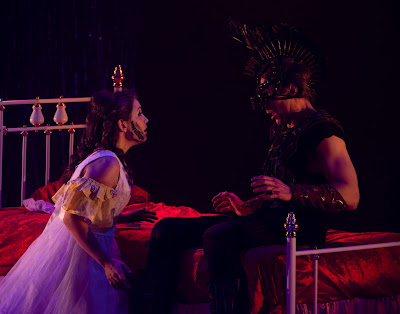https://www.limelightmagazine.com.au/reviews/the-enchanted-pig-gertrude-opera-yarra-valley-opera-festival/
Published online at Limelight Magazine, 21st October 2019
There’s a lot of singing about love in English composer Jonathan Dove and librettist Alasdair Middleton’s The Enchanted Pig. Loud and clear, you hear love is a wonder, love is strange, and love is a drug. It can make you happy, a hero and a fool. For a princess in love with a pig who is actually a king under a spell that she sets out to break, it turns out that love, among many things, is a journey of patience, trust and perseverance. And it unfolds with the help of the North Wind, the Moon and the Sun, as well as the Milky Way, as part of a splendidly rendered staging by Gale Edwards in Gertrude Opera’s Australian premiere of the work at the Yarra Valley Opera Festival.
 |
| Naomi Flatman, Joshua Oxley, Sheridan Hughes, Yu Lin and Sam Roberts-Smith |
In Joseph Noonan’s simple, punchy design, three chairs on a checkerboard floor lead to stately double doors surrounded by a tinsel curtain. The vitality, colour and beauty that follow are nothing less than uplifting under Jason Crick’s commanding lighting. Noonan’s layout lends itself superbly to the quick-paced nature of the work, with Edwards’ variety act-like moments keeping the action flowing with scenes that explode onto the stage and evaporate in a flash.
 |
| Naomi Flatman as Flora and Sam Roberts-Smith as the Pig |
Resonant, muscular in voice and often accompanied with an air of unflattering brass, baritone Sam Roberts-Smith is something of a cross between gladiator and subject of bondage as the Pig by day, and a figure of dashing masculinity by night. He may have the title role but vocal parts are spread generously across the cast. Mezzo-soprano Naomi Flatman is outstanding as the besotted Flora, with vocal colours aplenty and convincing in making palpable the character’s determination and resilience. Flora’s loving sentiments weren’t instantaneous, having seen sisters Mab and Dot – Sheridan Hughes and Yu Lin do a fine job in hamming it up as princesses – in their happy unions with the King of the West (Joshua Oxley) and the King of the East (Harry Grigg). Grigg makes a particularly good impression, his radiant tenor beautifying his aria as the Pierrot-like guiding Moon, while Oxley doubles as a Eurotrash attired Sun in a hilarious hip-swinging encounter.
Evil gets whipped up by the rich and ripe voiced Rose Nolan as the Old Woman who also doubles as Mrs North Wind. Zoe Drummond, as her vixen-like daughter, Adelaide, launches into one of many performance highlights with a bridezilla outburst in front of her wedding caterers, her soprano assured, athletic and penetrating. As Flora’s father, Markus Matheis is a magnetic King Hildebrand, giving pliable expression in both physical and vocal form, carried through in his duet as Mr North Wind with Nolan’s Mrs North in a brilliant, comic description of love. And Alexandra Amerides is quite literally a pedestal of support as The Book of Fate, who seals Flora and her sister’s future after they enter a room forbidden by their father.
 |
| The cast of The Enchanted Pig |
Take someone you love to see The Enchanted Pig. Its spirit and intensity will reverberate long after the joyous ending and it’s less than an hour’s drive to the enchanting Yarra Valley for added special effect. While you’re deciding, there’s a re-envisioned production of Verdi’s Macbeth by award-winning director Luke Leonard to consider as well and, extending the timeline further back, another Gale Edwards production in Monteverdi’s The Coronation of Poppea.
The Enchanted Pig
Gertrude Opera, Yarra Valley Opera Festival
Olinda Yarra Estate
Until 27th October 2019
Production Photos: Lyz Turner-Clark




